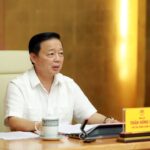
The Hanbaram Wind Power Plant project in Thuan Bac District, Ninh Thuan Province, has been put into commercial operation. (Photo: Cong Thu/VNA)
|
The transition from fossil fuels to greener, cleaner, and more environmentally friendly energy sources is a key goal for oil and gas companies, ensuring both national energy security and a reduction in emissions.
However, to turn this national goal into a reality, policy changes are urgently needed to speed up progress.
“Green electricity” projects are falling behind schedule
According to the Power Development Plan VIII, from now until 2030, the total additional capacity from gas-fired power projects is expected to be 30,424MW, and offshore wind power projects will add another 6,000MW, accounting for approximately 50% of the total capacity required.
These green energy projects play a crucial role in both supplying the national electricity system and helping Vietnam fulfill its commitment to achieving carbon neutrality by 2050.
Of the 23 planned gas-fired power projects, a total capacity of 30,424MW is expected to be invested, constructed, and operated from now until 2030. Among these, 10 projects will utilize domestically extracted gas with a total capacity of 7,900MW, while 13 projects will use imported LNG with a total capacity of about 22,400MW.
However, according to the Department of Electricity and Renewable Energy (under the Ministry of Industry and Trade), only the O Mon Thermal Power Plant (with a capacity of 660MW) has been put into operation using oil and will later use gas from Lot B. The Nhon Trach 3&4 Power Plant project (with a total capacity of 1,624MW) using imported LNG from Thi Vai port (Ba Ria-Vung Tau province) has achieved only 85% progress so far.
 O Mon Thermal Power Plant in O Mon Power Center, Can Tho City. (Photo: Thanh Liem/VNA)
|
The remaining 18 gas-fired power projects are still under construction, including 9 projects using domestic gas and 3 projects in the process of selecting investors with a total capacity of 4,500MW.
For offshore wind power projects, there is currently only one project that has been granted permission by the Prime Minister to conduct surveys and pre-feasibility studies. This project is a collaboration between the Vietnam Oil and Gas Services Corporation and a partner from Singapore.
On August 28, the Vietnam Oil and Gas Services Corporation (PTSC) and Sembcorp Utilities Pte. Ltd. (SCU) of Singapore held a ceremony to award the contract for wind, hydrological, and geological surveys and research for the project on exporting renewable energy from Vietnam to Singapore.
Mr. Le Manh Hung, Chairman of the Members’ Council of the Vietnam National Oil and Gas Group (Petrovietnam), stated that this event marks an important milestone in the implementation of offshore wind power projects by the two countries, gradually realizing Vietnam’s commitment to reducing net emissions.
Persistent obstacles
Explaining the slow progress of “green electricity” projects, Dr. Nguyen Quoc Thap, Chairman of the Vietnam Oil and Gas Association, pointed out that there is a lack of guidance on the procedures and approval process for adjusting the power development plan for investment projects. Additionally, financial mechanisms and capital arrangement for project implementation remain challenging due to the 15% limit on safe credit ratio to charter capital when providing loans according to the Law on Credit Institutions, as the capital required for large-scale power projects is substantial.
Moreover, most power projects are not eligible for government guarantees, making it difficult for state-owned enterprises like Petrovietnam, Vietnam Electricity (EVN), and Vietnam National Coal-Mineral Industries Group (Vinacomin) to arrange capital.
Another issue is the delay in issuing preferential policies for investment in power projects and those utilizing renewable and new energy sources, as stipulated in the Law on Electricity.
For power projects using imported LNG, the growth in the consumption market has been slower than the target set in the Power Development Plan VIII. At the same time, the legal framework to expedite the negotiation and signing of legal-economic-trade agreements among entities in the LNG-related project chain remains incomplete.
There is also a lack of specific guidance on the mechanism and criteria for selecting investors in the construction of infrastructure for LNG imports, as well as a lack of mechanisms to guarantee foreign currency conversion and international payment obligations for LNG imports for gas-fired power projects, emphasized the Chairman of the Vietnam Oil and Gas Association.
Representatives of Vietnam Gas Corporation (PV GAS) shared that with the decline in domestic gas sources faster than expected, PV GAS is focusing on investing in LNG import terminals to ensure supply for power generation and other industrial production sectors.
However, PV GAS is facing challenges and obstacles regarding policies related to the import of LNG, including the absence of a mechanism to guarantee the volume, a mechanism to convert LNG prices to electricity prices, and regulations related to associated costs such as freight charges. These issues complicate the determination of total investment, electricity selling prices, and hinder negotiations on commercial agreements in the LNG value chain.
For offshore wind power projects, there are inconsistencies and a lack of clarity in the current legal documents regarding the approval of investment proposals and the selection of investors.

There are inconsistencies and a lack of clarity in the current legal documents regarding the approval of investment proposals and the selection of investors for offshore wind power projects. (Source: VNA)
|
The Law on Bidding, the Law on Investment, and the Law on Land do not clearly specify the authority and procedures for approving investment proposals for offshore wind power projects at different administrative levels.
There is also a lack of specific guidance on the procedures for investigation, survey, exploration, and measurement at sea, as well as the allocation of sea areas for investment in offshore wind power projects. Additionally, there is no policy framework for pricing and tariff mechanisms.
Policy solutions
To accelerate the development of “green electricity” projects, Dr. Nguyen Quoc Thap, Chairman of the Vietnam Oil and Gas Association, suggested amending and supplementing relevant laws in a synchronized manner. These include the Law on Electricity, the Law on Environmental Protection (regulating the measurement and standards for CO2 emissions, and conditions for emissions trading), the Law on Taxation (tax and fee policies for investment and operation of LNG-fired power projects and offshore wind power projects, export electricity tax, emission standards, and tax and fee framework for buying and selling CO2 emissions), the Law on Marine and Island Natural Resources and Environment, the Law on Investment, the Law on Bidding, the Law on Construction, and the Law on Land.
Additionally, it is necessary to develop the electricity market in line with the goals of the Power Development Plan VIII, focusing on synchronously building LNG terminals, power plants, and industrial parks with a large enough demand for electricity. Diversifying investment in transmission infrastructure for domestic consumption and export, especially for LNG-fired power plants and offshore wind power projects, is also crucial.
Particularly, amending the regulations on the organization and operation and financial regime of state-owned economic groups in the energy sector, such as Petrovietnam, EVN, and Vinacomin, is of great importance. These amendments should focus on providing guidelines on capital arrangement for projects that are not eligible for government guarantees and allowing these groups to mortgage assets in gas and electricity trading transactions within the LNG project chain and with electricity consumers, as emphasized by the Chairman of the Vietnam Oil and Gas Association.
To address the challenges faced by offshore wind power projects, Dr. Ngo Duc Lam, Energy Expert and former Vice Director of the Energy Institute (under the Ministry of Industry and Trade), suggested that in Vietnam, only large corporations and companies with experience and strong financial capacity can participate in such projects. Therefore, currently, only Petrovietnam and EVN have the capability to implement pilot offshore wind power projects.
With their experience in offshore oil and gas operations and technological capabilities, Petrovietnam also has an advantage in arranging capital compared to other enterprises. Thus, facilitating Petrovietnam to pilot the first offshore wind power project would entail lower risks.
Currently, the Vietnam Petroleum Institute (VPI), a member unit of Petrovietnam, has proactively conducted research and cooperated with international partners to assess geological, environmental, and hydrological conditions of the seabed. They are also applying advanced artificial intelligence to analyze high-resolution seismic data and integrate geological and geotechnical data into a comprehensive foundation model for designing foundations, selecting optimal locations for offshore wind turbines, and determining routes for underground cables to transmit electricity.
Petrovietnam has received proposals from major global corporations such as Equinor, Orsted, CIP, and Macquarie to collaborate on developing offshore wind power projects in Vietnam. Petrovietnam has signed memorandums of understanding with Equinor and CIP (Denmark) to explore opportunities in offshore wind power and other clean energy sources in Vietnam.
Notably, in the past three years, PTSC, a member unit of Petrovietnam, has won bids for more than 10 offshore wind power projects with a total capacity of 5.2 GW. PTSC is involved in providing services for almost all stages of these projects, including surveys, design, procurement, construction, transportation, installation, operation, maintenance, and repair.
Earlier, on July 26, at a meeting to discuss the draft proposal for the pilot development of offshore wind power, Deputy Prime Minister Tran Hong Ha emphasized that the proposal has been of great concern to the Government and the Prime Minister for a long time.
Therefore, the proposal should identify specific projects and point out legal, research, survey, policy, investment procedure, and financial obstacles in implementing the entire project. Based on this, feasible pilot solutions can be proposed to overcome these challenges.
Anh Nguyen
The Electric Revolution: 100% Electric Bus Fleet for Hanoi
The bustling cities of Hanoi and Ho Chi Minh City are set for a green revolution. A plan is in motion to replace the entire bus fleet in these metropolises with environmentally-friendly alternatives. This ambitious project aims to reduce the carbon footprint of public transportation and offer a cleaner, greener future for all.
The Government Subsidizes Electric Cars to Make Them More Affordable for Citizens.
Encouraging the use of green transportation such as electric cars will be a key focus for the government in the coming years. With a vision to foster a sustainable future, initiatives will be implemented to promote eco-friendly alternatives. This includes offering incentives for those who choose environmentally conscious options, as well as developing infrastructure to support this green transition. The goal is to create a greener and healthier environment for all, and the government is committed to leading the way towards a more sustainable tomorrow.



















